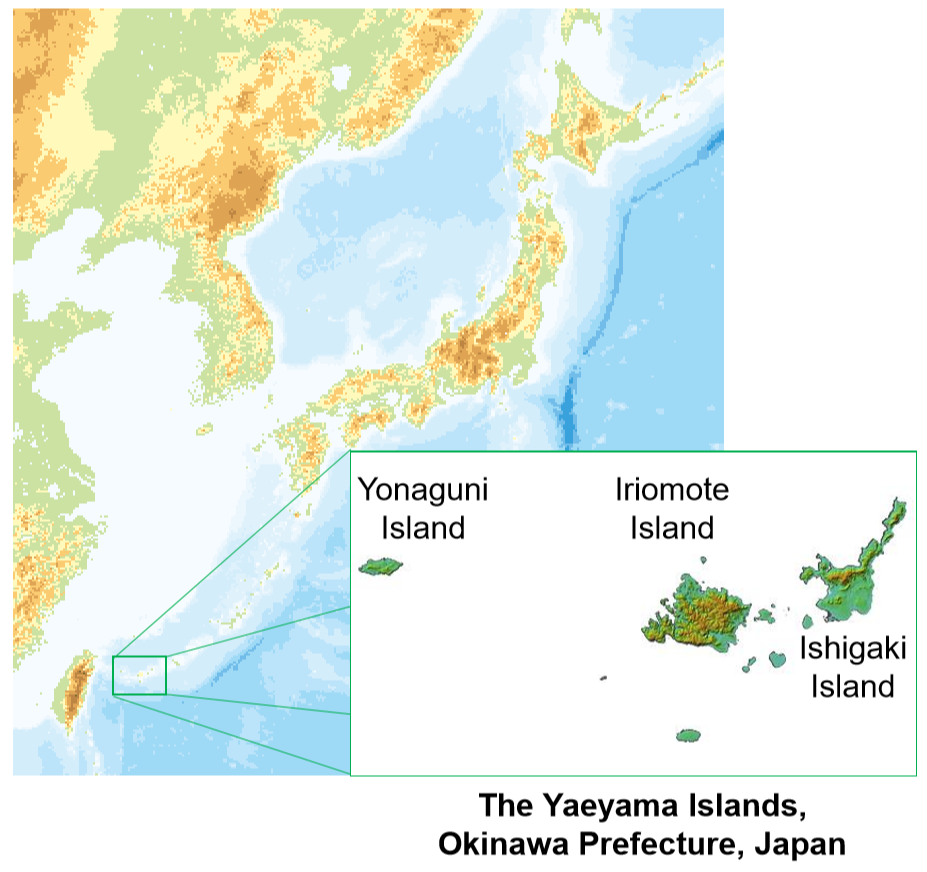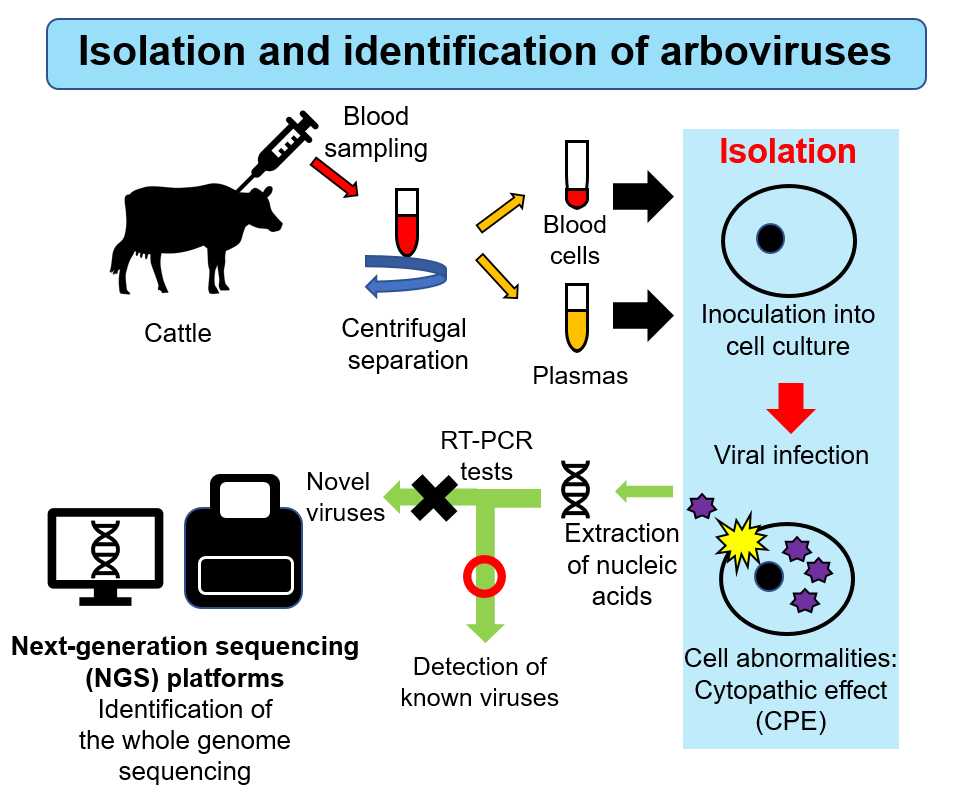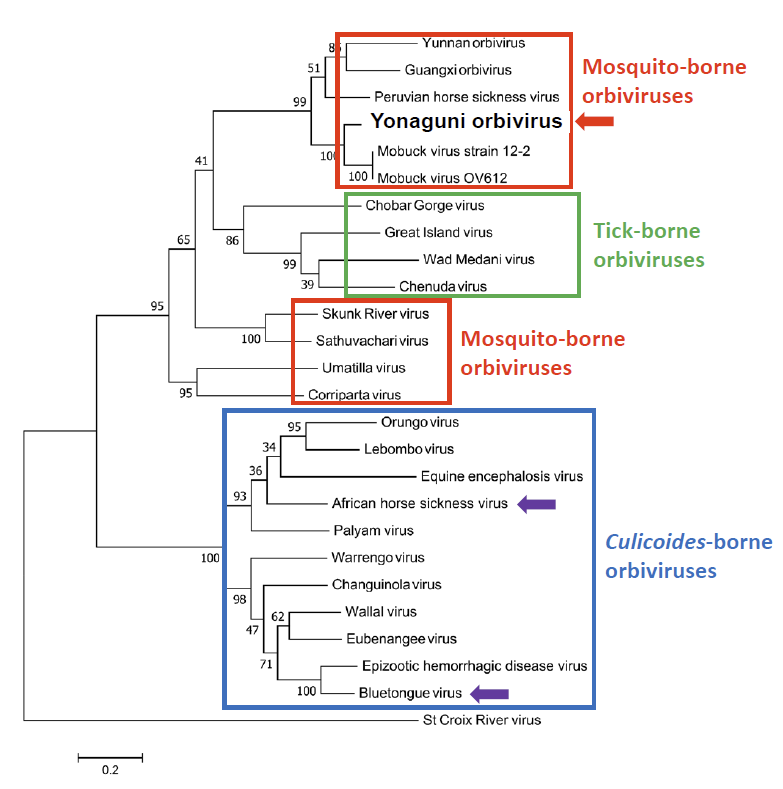Arthropod-borne viruses (Arboviruses) are transmitted by Culicoides biting midges, mosquitoes, and ticks, etc. Some of the species are known for causing severe illness to humans and domestic animals, and the prevention and the control of an epidemic is a critical issue. Early detection of invasion is crucial in preventing infections from spreading to the rest of the country. The National Agriculture and Food Research Organization (NARO) and Okinawa Prefecture have been conducting long-term surveillance of the arbovirus in the Yaeyama Islands, located in the most southwestern area of Japan, for over 25 years. Our continuous activity had accomplished the isolation of the novel orbivirus, designated Yonaguni orbivirus, from bovine blood samples and determined its whole-genome sequence. With the concern of other arboviruses to enter the country, we will continue to strengthen the surveillance of arboviruses at the border and promote research to develop detection methods of unknown viruses.
Overview
Arboviruses are transmitted by Culicoides biting midges, mosquitoes, and ticks, etc., and some of the species cause illness to humans and domestic animals. In Japan, especially in the southern islands of Kyushu and Okinawa, the spread of arboviruses has repeatedly caused infections in domestic animals accompanied by serious illnesses, resulting in huge economic losses in the livestock industry.
Analyzing the past cases suggests many of the arboviruses were brought into the country by infected vector insects moving across the sea. NARO, in cooperation with Okinawa Prefecture, had been conducting long-term surveillance over bovine arbovirus infections in the Yaeyama Islands in Okinawa Prefecture since 1994. The Islands are located in the most southwestern area of Japan, close to the tropical and subtropical Asian countries where arboviruses circulate throughout the year.
In a recent study, an unknown virus was isolated from bovine blood collected on Yonaguni Island. After the whole-genome sequence was determined using the next-generation sequencer, the unknown virus proved to be a novel virus in the genus Orbivirus, family Reoviridae, designated Yonaguni orbivirus. We will continue the further investigation to clarify its pathology, vectors, and distribution outside the Yonaguni Islands.
The discovery of the Yonaguni orbivirus indicates that the continuous surveillance in the Yaeyama Islands is effective in providing an early warning before the infection leads to a major outbreak in the rest of the country and for gaining information on bovine arbovirus circulation in neighboring regions.
Publications
Murota K, Suda Y, Shirafuji H, Ishii K, Katagiri Y, Suzuki M et al. Identification and characterization of a novel orbivirus, Yonaguni orbivirus, isolated from cattle on the westernmost island of Japan. Arch Virol 2020 165(12):2903-2908.
https://doi.org/10.1007/s00705-020-04803-3
For Inquiries
Contact: http://www.naro.affrc.go.jp/english/inquiry/index.html
Reference Information

Fig.1 Geographical location of the study area
The Yaeyama Islands in the subtropical region are made up of several islands, including Yonaguni Island, the most southwestern island in Japan.

Fig.2 The isolation process of arboviruses
Collected bovine blood samples go through a centrifugal separation, and separated blood cells and plasmas are inoculated into a cell culture. If there is a virus contained in the inoculated blood components, it will increase with time and induces a reaction called a cytopathic effect (CPE), observable abnormalities in cell shape. For identifying a known virus, reverse transcription-polymerase chain reaction (RT-PCR) tests are useful. However, the case of a novel virus requires an identification of the whole genome sequence by a high-throughput sequence analysis using next-generation sequencing (NGS) platforms.

Fig.3 Phylogenetic tree of the genus Orbivirus
The phylogenetic tree above shows the similarity and differences between the orbivirus taxa, including the Yonaguni orbivirus identified in the study, which is pointed with the red arrow. The numbers at the branches are the bootstrap (%), a confidence level of the classification for each taxon (max. 100). A higher value represents higher accuracy in the estimation of the branch. The length of the horizontal lines called scale bars represents the degree of evolution in each taxon. The longer bar represents a larger degree of evolutional change or mutation. The viruses which are pointed with purple arrows (African horse sickness virus, Bluetongue virus) need special attention for epidemic prevention and securing animal health. Phylogenetic analysis revealed that the newly identified virus is grouped with mosquito-borne orbiviruses that had been detected in China, North America, and South America.




